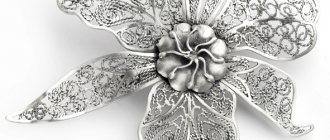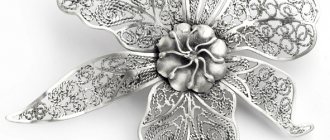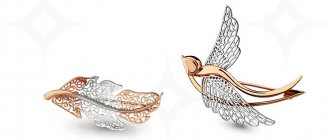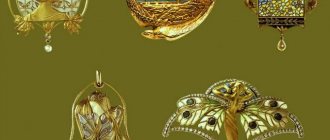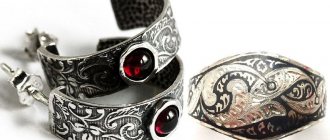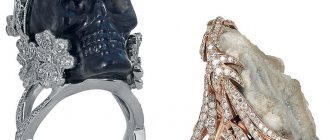When creating jewelry, masters use a large number of different techniques and techniques: thanks to them, each item acquires its own unique mood, value and significance. And, first of all, the quality of the jewelry depends on the skill and experience of the jeweler, because techniques such as filigree or granulation require enormous concentration, precision of movements and perseverance in their work.
We invite you to learn more about different jewelry techniques and their history.
Filigree and filigree
Photo of a product made using the filigree technique (filigree)
The filigree technique consists of creating an ornament by soldering elements of thin wire of precious and base metals together. The resulting lace can be soldered onto any base (soldered filigree) or form an airy pattern (openwork filigree).
The term “filigree” itself comes from two Latin words: filum, which means “thread,” and granum, which means grain. In Rus', this technique acquired the name “scan” from the Old Russian “skati”, that is, “twist”, “twist”. Russian filigree technology originated in the 10th – 12th centuries, and by the 19th century it had already acquired the status of art. Decorations, vases, boxes, and decorative panels were made using filigree.
| Christmas ball-box made using filigree technique). Photo: Zlat-Dar | Flash drive decorated using filigree technique |
The essence of the filigree technique is quite simple, but it requires a high level of artistic and jewelry skill, since the entire process is exclusively handmade. First, a sketch of the future pattern is drawn on life-size paper. Then its elements are created from smooth or pre-twisted wire, which are glued to a paper sketch - they must exactly repeat the drawing. Under the influence of the flame of a special burner, the parts are soldered into a single pattern, and the paper is completely burned.
The village of Kazakovo, located in the Nizhny Novgorod region, has become the center of modern filigree art. The first workshop opened here in 1939, and today it is already a large one. The range of products is incredibly wide: jewelry, decorative elements, orders and medals, church and religious items. Due to their high quality and artistic value, the plant's products are successful in the domestic market and abroad.
Filigree, filigree, granulation
.
The term “filigree” is more ancient; it comes from two Latin words “phylum” - thread and “granum” - grain. The term “scan” is of Russian origin. It originates from the ancient Slavic verb “skati” - to twist, twist, twist. Both terms seem to reveal the technological essence of this art. The term “filigree” combines the names of the two main primary elements from which filigree products are made - wire and small balls that complement the wire pattern. Openwork filigree is a processing in which a pattern consisting of elements made of wire is soldered only to each other, without a background, forming a kind of metal lace, and the grain used in this case is soldered onto this lace
In addition to rolled filigree, smooth rolled (or simply round) wire, the so-called satin surface, is also used for filigree, which in combination with filigree significantly enriches the design.
Filigree cords are distinguished by thickness and pattern. They are prepared in various ways. The simplest skin is woven in the same way as filigree, from two, but thicker wires, but is not rolled, and it remains round in its cross-section. More complex cords are twisted from three or four wires. A cord acquires an interesting pattern if, twisted from two wires, it is folded in half and twisted again; at the same time, it becomes dense and complex in structure. If you re-twist the lace in the opposite direction, it becomes looser and more original in design. This type of lace adds special beauty and richness to the composition. A cord twisted from two wires of different thickness takes on a unique character.
One of the very beautiful elements of scanned works is “grain” (small balls). It significantly complements and enriches the linear pattern made of wire, and is reminiscent of pearl hems in sewing.
In the past, each product - from wire preparation to final soldering and mounting - was made by one highly skilled filigree master, and he was usually also the creator-artist, the author of the product.
To give the product a special expressiveness, and at the same time protect it from the influence of the external environment, a protective film is applied to it. For example, a copper product made from expanded tin can be decorated with sulfur liver. The patination solution is applied to a large item with a brush, and a small item is dipped directly into the solution.
.The finished product - be it jewelry, sculptural casting, embossed relief or tableware with a utilitarian purpose - must undergo decorative finishing at the final stage. It not only improves the appearance of the item, but also protects it from corrosion. A well-finished product is pleasant to hold. It is hygienic, as all kinds of contaminants can be easily removed from it. Over the course of many centuries, craftsmen have invented more and more new ways of finishing metal. They learned to grind and polish the surface of metal products, give it a rough texture if necessary, and paint it. There are many recipes for applying the thinnest protective films in a wide variety of colors. In the Middle Ages, the texture and color of metal had a deeply symbolic meaning. This was taken into account when making all kinds of coats of arms on metal. Thus, blued iron, silver polished to a mirror shine, and gold with a shot surface formed by tiny dotted depressions were considered “heraldic.”
. A polished metal product is polished using special polishing pastes, which may include chalk, lime, dolomite, chromium, aluminum, and iron oxides.
To polish metal in everyday life, chalk or tooth powder moistened with water is often used. A good polishing paste can be easily prepared from tooth powder by mixing it with ammonia until a creamy mass is formed. Copper and its alloys - brass and bronze - are especially well polished with this paste.
By the end of summer, in August, somewhere at the garden gate a ready-made natural paste was already stored for a villager. It was enough to pick a bunch or two of ripe red elderberry berries and rub the samovar or some other copper utensil with its juice so that the copper surface would light up and shine with many reflections. By the way, red elderberry was planted near the house also because with its ripe, juicy fruits one could, on occasion, wash one’s hands well of all kinds of dyes, especially of plant origin. Even in ancient times, craftsmen used various dried herbs to polish metal and stone, among which especially Eelgrass and horsetail were and remain popular to this day. Eelgrass is collected from the seashore after low tides and is only available to residents of coastal areas. Various types of horsetail can be found in all corners of our country: in the forest, in the field, in low swampy places. In the forest, in shady places, wintering horsetail is found in abundance; in meadows and fields, horsetail grows like a weed; in damp places, large thickets of riverine horsetail are found. These types of plants can be successfully used for polishing, since all their parts contain tiny particles of silicon. But the so-called wintering horsetail, which grows in the forest, is richest in silicon. The grass is cut with a sickle, knife or scissors and dried in the sun. You can polish with dry or slightly moistened grass. Sometimes parts of a dried plant are glued onto paper and used in the same way as sandpaper.
The techniques that were used by the old jewelers of Central Asia and which are still used by some tribes in Afghanistan are diverse. They use casting, forging, embossing, embossing - basma technique, niello, openwork and applied filigree, enamel, granulation, perforated carving, cloisonné inlay, gilding and silvering. Casting was rarely used to make products from precious metals, since few massive things were made.
Author: Alexander Emelianenko
literature - A.D. Stolyarov, M.T. Demina and others. “Technique of artistic enamel, embossing and forging” M. “Higher School” 1986
livejournal
Published based on materials:
- Fakhrettinova D.A. Jewelry art of Uzbekistan. Tashkent. Publishing house lit. and art. 1988. - 204 p.
.
Grain
| Buttons from the 17th–18th centuries. Silver, filigree, gilding, granulation. Photo: Russian Ethnographic Museum | Ring decorated using the granulation technique |
In Russian jewelry art, filigree and granulation techniques are inextricably linked. Grain is usually used to complement filigree patterns, giving them a fuller and more finished look. The simple name of the technique fully reflects its essence. Grain is an ornament created from small, 0.3-0.4 mm in diameter, gold, silver or platinum grains. The balls are installed in pre-prepared recesses in the pattern on a thin layer of solder, which fuses them with the base in the flame of the burner. It is important that the solder can securely secure the pattern, but does not disrupt its clarity by spreading beyond the recess. In Rus', gold leaf mixed with mercury was used for these purposes; during the soldering process, the mercury burned out, and the gold quickly melted, forming a reliable adhesion.
Another condition for creating a high-quality pattern is the same size of all grains. To obtain them, thin wire is cut into small pieces, which are placed on pieces of charcoal, where recesses of a given diameter are located in rows; the molten wire flows into them, forming small balls, which will later be used for decoration.
Filigree and grain
Silver filigree rusk bowl. Moscow, 1819
Filigree (from the Latin filum - wire) or filigree (from the Russian "skat" - to twist) is a decoration made of thin gold or silver smooth, tilted (corrugated) wires, which are rolled into spirals, tendrils, lattices and soldered to the object. Filigree is made from pure gold or silver, which, due to the absence of impurities, is soft and can be drawn into very thin wires. Silver filigree was especially preferred; gold filigree is less common. Cheap scanned items were also made from red copper wire and then gilded or silvered. The smooth wire is pulled through a series of holes in a steel plate fixed in a vice or drawing machine. Since the holes gradually decrease in diameter, the wire becomes thinner after each pass. In this case, you have to repeatedly anneal the wire so as not to tear it, and lubricate its pointed tip with oil or wax so that it fits easily into the holes. To obtain the thinnest wire, copper circles are used with a drilled diamond or sapphire inserted in the center, through the hole in which the wire is pulled.
Silver filigree spice box. Prague, 1830
In the manufacture of scanned products, smooth wire is used, passed through rollers, turning it into a ribbon or wire, tightly twisted into a rope of two or three threads using a twisting machine driven by a stick or bow. The use of wire of various thicknesses and the alternation of smooth and twisted wire gives the master the opportunity to introduce great variety into scanned patterns. If a filigree ornament is made on a metal background, then a pattern is applied to the surface of the metal, according to which pieces of smooth filigree and filigree twisted into ropes are bent and laid out with tweezers, while covering each piece with glue (carpenter's or acetone) and thus attaching it to the metal. When the entire drawing is laid out, the master tightly wraps the plate with the printed scanned patterns with the finest iron wire. This is done so that during further work the pasted filigree does not move from its place and the pattern does not go astray. The filigree collected on a plate and secured with wire is moistened with water, sprinkled with low-melting silver solder mixed with borax, a piece of charcoal or asbestos (or mica) is placed, which do not burn when soldering, and the filigree is soldered using a blowpipe. When making openwork filigree, the design is made on paper, to which individual detailed patterns are glued, and, sprinkled with solder, they are soldered in the usual way. The paper burns, and the scanned curls are soldered together. In ancient times, wire for filigree was not drawn, but forged - it was forged in small pieces, which, if necessary, were soldered together. In the 10th century, drawn filigree was already well known in Rus'.
Granulation or granulation (from the Latin granum - grain) is a method of decoration that involves soldering gold or silver grains onto an object (gold - onto gold, silver - onto silver). This technique increases the play of light and shade on the product and helps create a picturesque effect. Often grains were used to enliven filigree items. The use of grain is very diverse: it can be scattered throughout the filigree ornament, bordering parts of the object with stripes, arranged in the form of a grid, rhombus, triangles, and forming relief pyramids and clusters. The technique of making and fixing grain requires great skill from the master. In order to obtain a large number of grain balls of equal size, the master must, first of all, cut pieces of wire equal in length and diameter. To speed up this process, the craftsman winds the wire around a cylindrical rod and then cuts the spiral. The unclosed rings of equal size obtained in this way are laid out with tweezers on a large piece of charcoal with rows of small depressions on it, after which a jet of flame from a blowtorch is directed at them. The molten rings in the form of drops roll into depressions made in the coal and solidify into balls. Grain can also be obtained in another way: rings or pieces of wire are not laid out on a lump of coal, but sprinkled with coal dust and melted in a crucible. Balls of grain are glued to the appropriate places in the ornament, sprinkled with solder and soldered, often placing filigree rings under the balls.
When making filigree and decorating it with grain, one of the most important issues is the issue of solder. On ancient products it is almost invisible - as if invisible glue holds the details of the ornament to the surface of the product. This is undoubtedly a great advantage. The question of the composition of this solder occupied scientists for a long time, and in 1952, as a result of experiments by F.Ya. Mishukov's lost secret of the ancient technique of invisible solder was revealed.
False filigree and grain. The manufacture of products decorated with grain and filigree required great skill from the craftsmen and took a lot of time. Craftsmen of the XII-XIII centuries. simplified, accelerated and reduced the cost of the process of making jewelry by casting copies of precious objects decorated with filigree and grain in stone molds from slate and limestone. The result was cast objects, similar to decorated grain and filigree, but with a slightly blurred, unclear pattern.
To the beginning of the “Jewelry” section>>>
Blackening
| Silver ring with blackening | Blackened silver bracelet |
The blackening technique is also a fairly old jewelry technique. The blackening composition is applied to the surface of the product in accordance with the design, then the black is melted in special ovens, forming a contrasting pattern. Each master has his own recipe for the mixture for blackening; the color and strength of the coating, its thickness and density depend on its composition.
Often, to give the ornament clarity and texture, filigree and grained products are blackened. Also, a three-dimensional design can be applied using the methods of hollowing, chasing, and engraving.
Among all metals, blackening of silver is the most common, since in this case the product not only acquires a richer and more noble appearance, but also becomes resistant to chemical and mechanical damage. Gold and platinum are used less frequently only due to the fact that it is almost impossible to remove high-quality niello from the surface in the future, and such jewelry can no longer be melted down.
We hope that you found the information interesting and useful.
